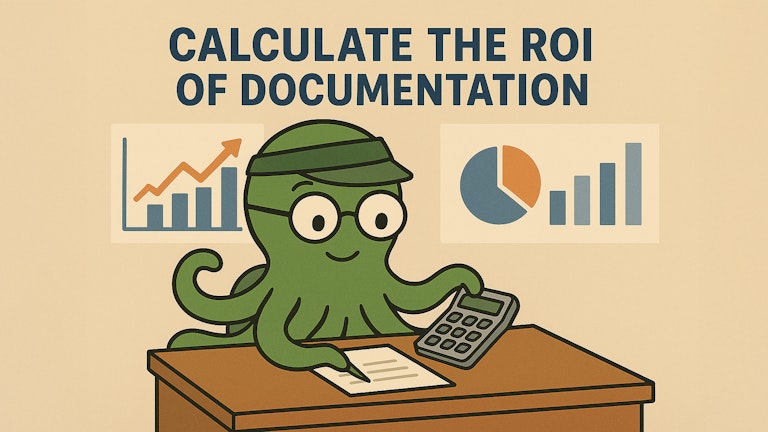Making a business case for documentation, post 8 - Calculate the ROI of documentation
 Ravi Murugesan —
Ravi Murugesan —  Lana Novikova
Lana Novikova This is the eighth post in a series about making a business case for documentation. We discuss how to calculate the return on investment (ROI) for documentation.

In our previous blog posts we’ve overviewed how to start building your business case step-by-step. The last step in this process is outlining the expected outcomes and benefits, one of which is highlighting the expected return on investment (ROI).
What is the return of investment for documentation?
Return of investment for documentation refers to the value gained from investing in producing documentation compared to the costs incurred. While the return on investment can be challenging to quantify accurately, it involves assessing tangible and intangible benefits and comparing those benefits with the costs associated with creating, maintaining, and using documentation.
Four-step process to calculate ROI
Step 1: List the benefits
List the tangible and intangible benefits of good documentation. For example, to support onboarding efficiency, enhanced user experience, improved productivity, and more.
Step 2: Choose relevant KPIs
Choose relevant key performance indicators (KPIs). Rita Khait from Zoomin suggests categorizing key performance indicators into three groups:
-
Infrastructure key performance indicators, covering traffic metrics, search-related metrics, and other web vitals.
-
Efficiency and cost reduction metrics, including IT and cloud costs, support costs, and employee onboarding time.
-
Revenue growth indicators, such as awareness, number of leads, and product adoption rates.
Step 3: Measure your cost factors
Estimate the costs associated with creating, editing, reviewing, and updating documentation content. Consider the time and resources invested by subject matter experts, writers, editors, and reviewers, as well as ongoing maintenance efforts.
You can also calculate the hidden costs of reading the docs, which are often overlooked.
As Henneke Duistermaat wisely notes in her blog post: "The LOWER the effort to read, the HIGHER the effort of the writer. Writing clearly and simply is hard work." This principle directly applies to all texts, including documentation. While it demands significant effort up front to create clear, simple texts, this "high writer effort" directly translates into "low reader effort" for your users and internal teams, which ultimately lowers the overall investment for those who need to read it.
Step 4: Quantify and monetize the benefits
Express the benefits in monetary value (it could be money or effort, such as person-hours). This is where your line manager can help you. You don’t have to come up with intricate calculations or a variety of numbers. Just one monetary figure that helps you emphasize the value of good documentation might be enough.
Use cases to calculate the return of investments
The following sections explain a few ways to possibly quantify ROI that you can lean on while calculating the return of investment for documentation.
Reduction in support tickets
Scenario: Your company provides software solutions to clients. Without comprehensive documentation, clients frequently contact your support team for assistance, leading to high support costs.
Calculation: Calculate the average hourly rate of your support engineers. Then, track the number of support tickets related to issues that could have been resolved with better documentation. Multiply the number of tickets with the average time spent per ticket and the hourly rate of support engineers. This will give you the potential cost savings from reduced support tickets.
Attracting organic traffic and conversion
Scenario: Your company offers a software product with extensive documentation. The documentation not only helps existing users but also attracts potential customers through organic search traffic.
Calculation: Analyze your website analytics to track the increase in organic traffic attributed to your documentation (redirects from a doc website to a product website). Then, measure the conversion rate of visitors who access your documentation to become paying customers. Multiply the increase in conversions by the average revenue per customer or a customer lifetime value to estimate the additional revenue generated through improved documentation.
Conclusion
While calculating the ROI of documentation may seem complex, the key is to focus on one or two meaningful metrics that align with your company’s priorities. Even a simple estimate can strengthen your case and increase buy-in from leadership. Armed with these calculations, you’re in a strong position to present your findings and advocate for the resources you need.
In the next post, we’ll look at how you can effectively present and defend your business case.
Text of article ©2025 Ravi Murugesan, Lana Novikova
Released under Creative Commons Attribution 4.0 International (CC BY 4.0)